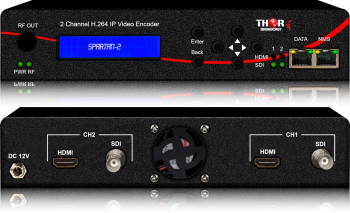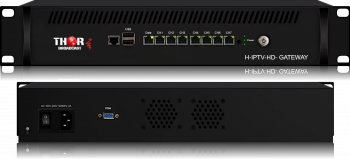These Pro DVB Broadcast Video H.264 Encoder offer a massive array of inputs and outputs to ensure that no matter what stream you're implementing or converting to will ensure that your next application or project will be successful the first time, every time. Using unique hardware and software the Thor Broadcast Professional encoders include options for HD-SDI, HDMI, ASI, IP, and codecs like MPEG2, H.264 and flexible audio and data rate options to manage any broadcast streaming in perfect HD quality. We are proud to present the Best H.264 Video Encoder Hardware with Advanced Video Coding(AVC) for IPTV Applications. All Our Units come with the Highest Quality Chips.
IPTV (Internet Protocol Television) continues to reshape the landscape of content delivery, integrating cutting-edge technologies for a seamless viewing experience. In this concise knowledge article, we delve into the evolution of IPTV, exploring the role of various streaming protocols like UDP, RTP, RTSP, HLS, RTMP, HTTP, NDS, while also examining the significance of SDI encoders and multi-channel encoders with 1-24 HDMI or SDI sources.
Streaming Protocols and their Impact
-
UDP and RTP: The speed and low latency of UDP make it ideal for live streaming, while RTP ensures real-time synchronization of audio and video.
-
RTSP: Real-Time Streaming Protocol plays a vital role in establishing and controlling media sessions, contributing to the seamless integration of IPTV.
-
HLS and RTMP: HLS adapts to diverse network conditions, while RTMP offers low-latency content delivery, both playing pivotal roles in the IPTV landscape.
At the heart of IPTV is the H.264 video compression standard, a key player in achieving high-quality, HD streaming. This compression technology is central to HDMI encoders, SDI encoders, and multi-channel encoders, ensuring efficient content delivery.
Beyond HDMI: The Emergence of SDI Encoders
While HDMI encoders play a crucial role, SDI (Serial Digital Interface) encoders bring another dimension to the table. Offering broadcast-quality video transmission, SDI encoders are becoming integral components in sophisticated IPTV setups.
The demand for diverse content sources has led to the rise of multi-channel encoders supporting 1-24 HDMI or SDI sources. These encoders facilitate the simultaneous streaming of multiple channels, providing scalability and flexibility for content providers.
Embracing Unicast and Multicast
IPTV's versatility is highlighted through its support for unicast and multicast transmission. Unicast ensures personalized content delivery, while multicast efficiently distributes content to multiple users simultaneously, optimizing bandwidth usage.
In conclusion, IPTV technology is a dynamic ecosystem where streaming protocols, H.264 or MPEG2 compression, HDMI and SDI encoders, and multi-channel capabilities converge. This amalgamation not only enhances the quality of content delivery but also opens up new possibilities for broadcasters and content providers. Understanding these components is crucial for navigating the evolving landscape of IPTV.

 ES
ES



















